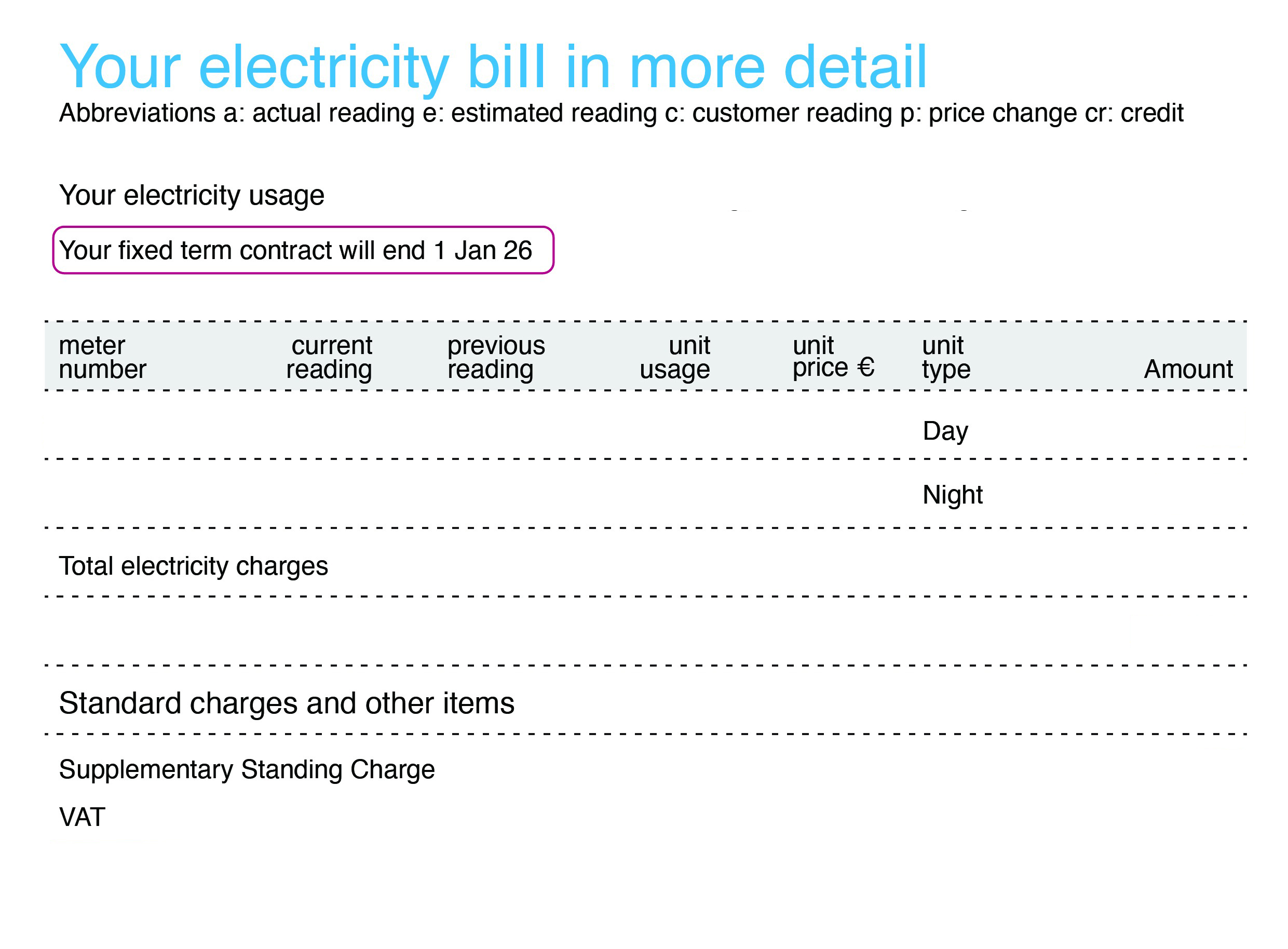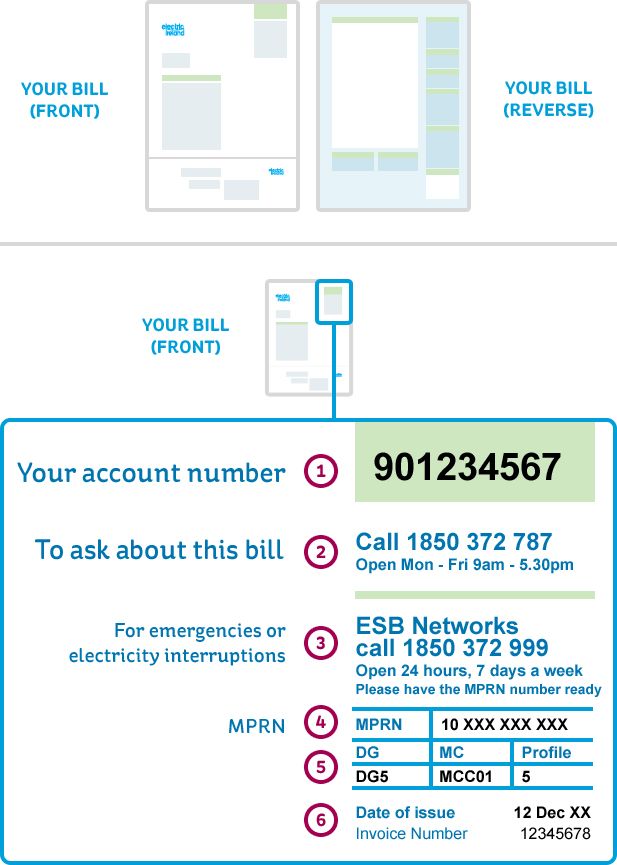Understanding your Electric Ireland electricity bill
Here are some of the terms you will find on your electricity bill:
1. Your account number
This is your Electric Ireland electricity account number. You should always quote this number when contacting Electric Ireland
2. To ask about this bill
Please contact us at 1800 372 787 with your account query.
3. For emergency or electricity interruptions
Please call ESB Networks on 1800 372 999 to report an electricity interruption or emergency.
4. MPRN
Your MPRN (Meter Point Registration Number) identifies your connection to the ESB Network and it is unique to your business. You’ll need to quote your MPRN if you call ESB Networks with a query.
5. DG, MC and Profile
This is used to identify your Meter Configuration and usage Profile.
6. Invoice Number
Each bill has its own invoice number.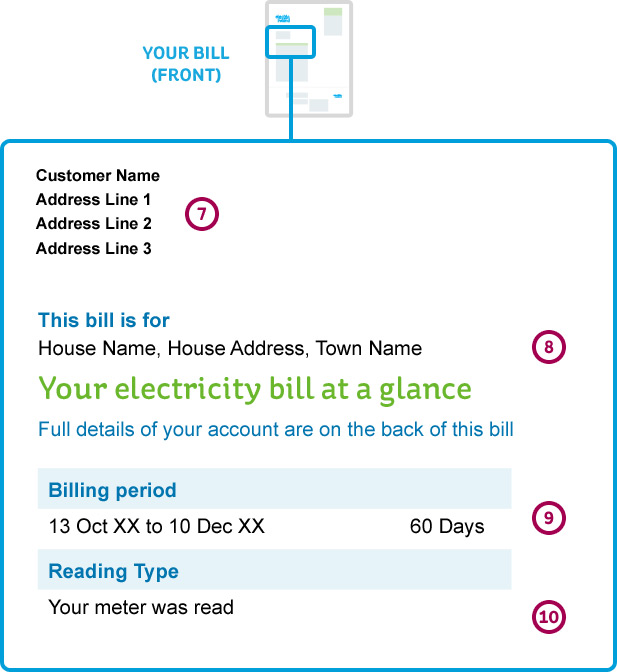
7. Bill Address
This is the postal address you registered with us initially.
8. This bill is for
An address will only be shown here on the bill if the postal address is different to the supply address.
9. Billing Period
This is the period for which your electricity usage is billed.
10. Reading Type
You will see one of the following messages on your bill:
- We read your meter: An ESB Networks technician visited your premises and read your meter.
- We estimated your usage: An estimated reading based on your previous readings.
- You read your meter: You supplied us with your meter readings.
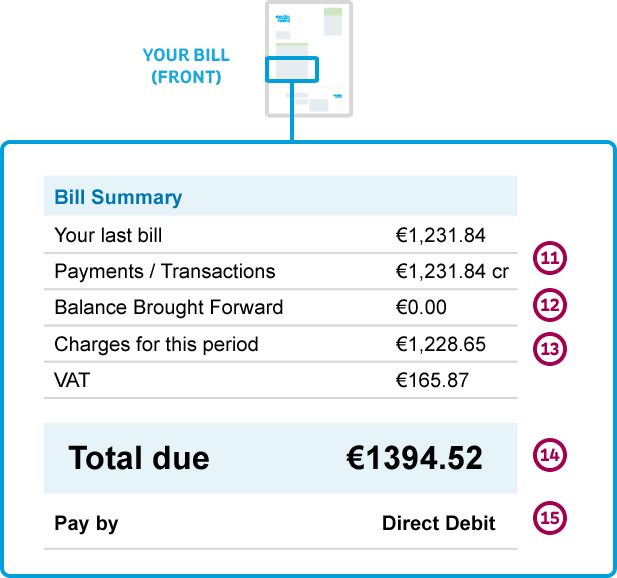
11. Payments
Here, you’ll see a summary of all financial transactions including your payments since your last bill.
12. Balance Brought Forward
This is the total balance due from your previous bill(s).
13. Charges for this Period
Please see the back of your bill for a detailed breakdown of your bill.
14. Total Due
This is the total amount due for payment. Payment options are listed on the back of your bill.
15. Pay By
All bills must be cleared by the payment date. 14 days credit is allowed for bills without arrears. Those with arrears are due immediately. If you pay by direct debit, the amount of the bill is automatically collected from your bank account 14 days later.
16. Remittance Advice
You should detach this and send in with non-direct debit payments.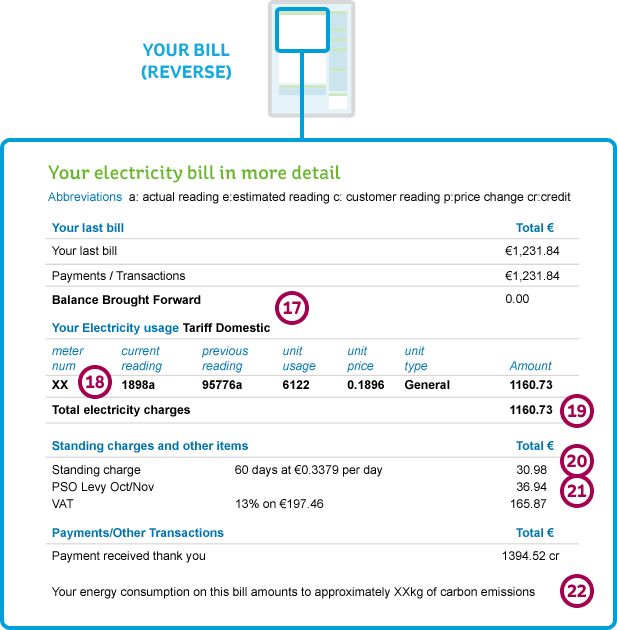
17. Price Plans
This is the name of your electricity price plan.
18. Meter Readings
Your present and previous meter readings are shown. Actual readings are indicated by an ‘a’ following you reading. Estimated readings are indicated by an ‘e’ and customer readings are indicated by a ‘c’.
19. Unit usage x Unit price
The total number of units used in your billing period multiplied by the price per unit. Each unit used represents 1 kWh.
20. Standing Charge
The standing charge is a fixed daily cost on your bill regardless of how much electricity you consume. It is a combination of the fixed charges associated with providing and maintaining the supply of electricity, the collection of meter readings and a share of the supplier costs in servicing
You will see one of the following descriptions on your bill:
Standing Charge: The standing charge is shown as a daily figure which is multiplied by the exact number of days that your bill covers.
Supplementary Standing Charge: This type of standing charge only applies where you use fifteen units or less of electricity on average per day in a billing period.
21. PSO Levy
The Public Service Obligation Levy (PSO) is mandated by the Government and approved by the European Commission to support the generation of electricity from sustainable, renewable and indigenous sources.
The levy is calculated and certified annually by the Commission for Regulation of Utilities (CRU) in accordance with relevant legislation and all energy suppliers are required to collect this levy from customers.
22. Carbon emissions
Shows the amount of kilograms of CO2 produced as a result of your energy usage this period.
If you are one of our Business Customers whose account number begins with a 2, you can view a sample of your bill here:
Front of Bill
Back of Bill
For our industrial business customers, you may also see some of these terms on your electricity bill:
Load factor
Load factor is the ratio of average electricity used, to the peak usage in a business premises during a specific period.
It indicates whether the electricity used in your business is stable or has extreme peaks. The lower the load factor, the more 'peaky' the loads. A very poor load factor would be less than 20%.
Power factor = 1 or less
This term describes the relationship between kW, kVAr, and kVA.
It is always 1 or less. For example, if your power factor equals 1, then the kW used is equal to the kVA.
If your power factor is less than 1, then you are using some wattless power on your premises. We will only charge you for wattless power when the power factor goes below 0.95.
Wattless unit (kVArh) = 1000 reactive volt-amps per hour
A kVArh is the unit of measurement for 'reactive/wattless' power consumed.
Electric power is made up of the following elements:
- 'active/real' power (kW)
- 'reactive/wattless' power (kVAr)Which equals the 'apparent' power (kVA).
Large motors require 'reactive/wattless' power to operate correctly. Your business can reduce/eliminate reactive power by fitting power factor correction equipment. Please discuss with your electrical contractor.
Wattless charges are recorded on a separate meter.
Kilowatt (kW) = 1000 watts (W)
A kW is the term used for 'active/real' electric power, it’s also known as 'Demand' or 'Load'.
Electric power is made up of the following elements:
- Active/real power (kW)
- Reactive/wattless power (kVAr)
When these are combined, they are known as the 'apparent' power (kVA).
Megawatt (MW) = 1000 kilowatts (kW)
A megawatt is sometimes used as a unit of measurement for large electric loads provided to business customers.
Megawatt hour (MWh) = 1000 kilowatt hours (kWh):
MWhs are the measurement of energy used by large industrial businesses.
Kilovolt-Amp (kVA) = 1000 volt-amps
This term is used to describe the level of 'apparent' power imported by your business.
It is the basis of your MIC contract with ESB Networks.
Maximum Import Capacity (MIC) Charges
The Capacity Charge will be based on the contracted Maximum Import Capacity, agreed between the customer and ESB Networks. The charge will be pro-rated based on the number of days in the billing period.
Contract Expiry for Fixed Price Customers:
Customers on a Fixed Price contract can find their expiry date located on the reverse side of their bill, as shown in the image below.
